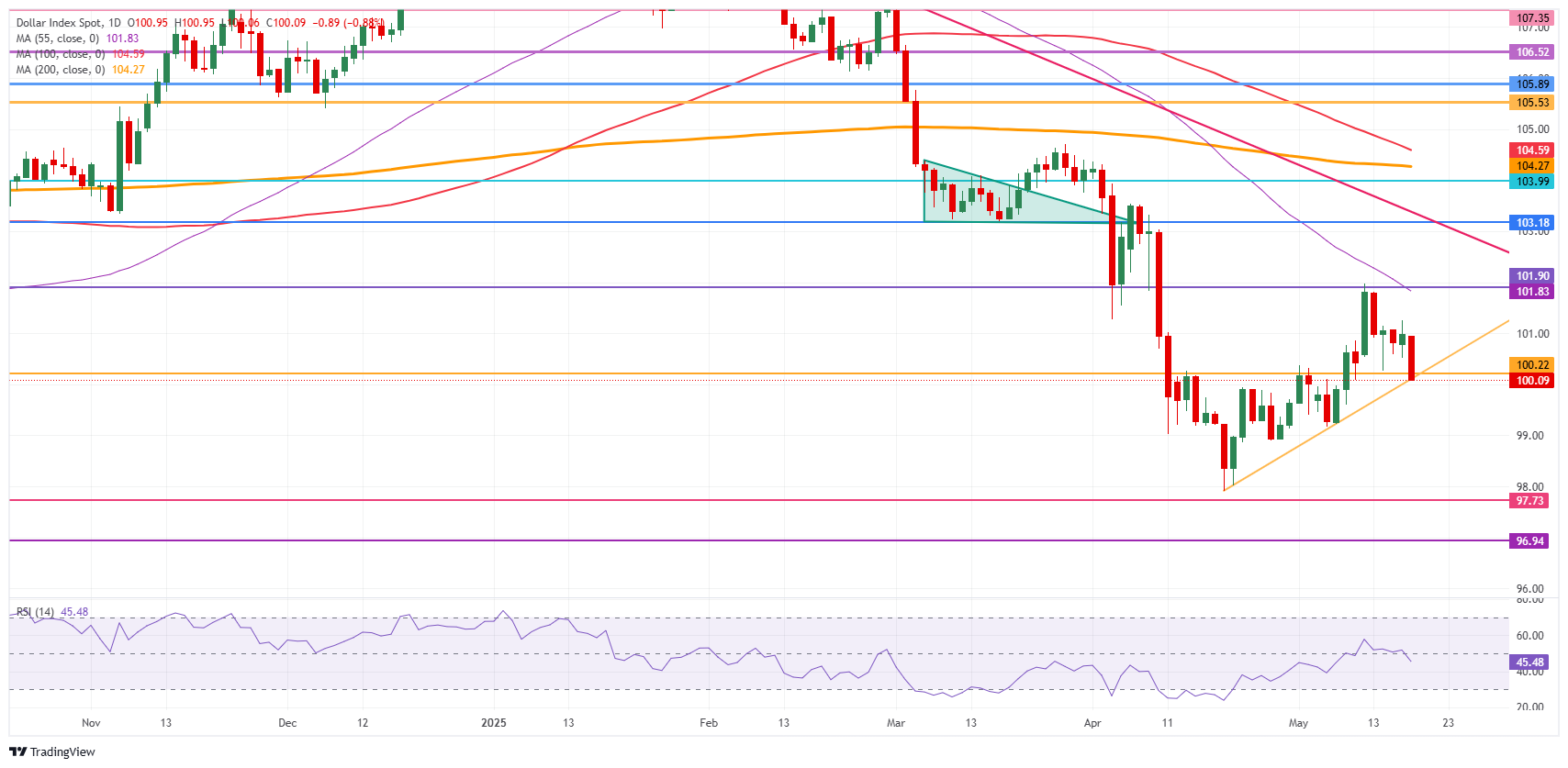US Dollar faces selling pressure after Moody’s US downgrade
- The US Dollar declines on Monday after rating agency Moody’s surprised markets on Friday.
- Expect to see some fallout still, while the Trump administration will try to convince markets with another trade deal or a Ukraine breakthrough.
- The US Dollar Index looks pressured, heading back to 100.00
The US Dollar Index (DXY), which tracks the performance of the US Dollar (USD) against six major currencies, is on the back foot on Monday and trades around 100.40 at the time of writing. The DXY is undergoing some selling pressure with the Greenback losing some support and trust in markets again. The fact that Moody’s announced on Friday that it downgraded the United States' (US) credit rating to 'AA1' from 'AAA' and said in its report that “while we recognize the US’ significant economic and financial strengths, we believe these no longer fully counterbalance the decline in fiscal metrics,” Moody’s calls out what several analysts have already pointed out since US President Donald Trump enforced tariffs, Reuters reports.
It will be interesting to hear what the Federal Reserve (Fed) thinks from a slew of Fed speakers this Monday. With this downgrade from Moody’s, yields will increase as market participants demand a small risk premium before considering buying US debt. That could be a setback for the Fed if the central bank wants to cut its benchmark rate, with a possible dislocation between the actual monetary policy and where US rates are in the normal bidding market.
Daily digest market movers: Bostic says ripple effect to take place
- An army of Fed speakers stands ready on an otherwise dry Monday in terms of US economic data:
- At 12:30 GMT, Federal Reserve Bank of Atlanta President Raphael Bostic spoke on a panel at the Atlanta Fed's 2025 Financial Markets Conference in Florida. Fed's Bostic said the downgrade could have a ripple effect through the economy. He went on by saying that another 3 to 6 months waiting time is needed to see how uncertainty settles. The longer tariff transition takes, the more it will impact consumer behavior, Bloomberg reports.
- At 12:45 GMT, Federal Reserve Bank Vice Chair Philip Jefferson delivers a speech about liquidity facilities at the Federal Reserve Bank of Atlanta in Florida.
- In that same timeframe, Federal Reserve Bank of New York President John Williams moderates a discussion at the MBA's Secondary and Capital Markets Conference in New York.
- At 17:15 GMT, Federal Reserve Bank of Dallas President Lorie Logan delivers opening remarks at the 2025 Financial Markets Conference in Florida.
- Closing off at 17:30 GMT, President of the Federal Reserve Bank of Minneapolis Neel Kashkari participates in a conversation at the Minnesota Young American Leaders Program (MYALP) at the University of Minnesota.
- Equities are not reacting well to the fact that the biggest developed economy in the world is seeing a downgrade on its credit rating. European equities are in the red while US Futures are substantially lower.
- The CME FedWatch tool shows the chance of an interest rate cut by the Federal Reserve in June’s meeting at just 8.3%. Further ahead, the July 30 decision sees odds for rates being lower than current levels at 36.8%.
- The US 10-year yields trade around 4.51%, a steep rally from 4.3%, the low of the past Friday.
US Dollar Index Technical Analysis: Another warning sign
The US Dollar Index is losing its creditworthiness and its safe-haven status. Moody’s only confirmed what several analysts have long predicted since the Trump administration went all-in on tariffs. The US Dollar is no longer stable, and it is only a matter of time before that translates into the DXY.
On the upside, 101.90 is the first big resistance again. It already acted as a pivotal level throughout December 2023 and as a base for the inverted head-and-shoulders (H&S) formation during the summer of 2024. The 55-day Simple Moving Average (SMA) at 101.94 reinforces this area as strong resistance. In case Dollar bulls push the DXY even higher, the 103.18 pivotal level comes into play.
On the other hand, the previous resistance at 100.22 is now acting as firm support, followed by the year-to-date low of 97.91 and the pivotal level of 97.73. Further below, a relatively thin technical support comes in at 96.94 before looking at the lower levels of this new price range. These would be at 95.25 and 94.56, meaning fresh lows not seen since 2022.

US Dollar Index: Daily Chart
US Dollar FAQs
The US Dollar (USD) is the official currency of the United States of America, and the ‘de facto’ currency of a significant number of other countries where it is found in circulation alongside local notes. It is the most heavily traded currency in the world, accounting for over 88% of all global foreign exchange turnover, or an average of $6.6 trillion in transactions per day, according to data from 2022. Following the second world war, the USD took over from the British Pound as the world’s reserve currency. For most of its history, the US Dollar was backed by Gold, until the Bretton Woods Agreement in 1971 when the Gold Standard went away.
The most important single factor impacting on the value of the US Dollar is monetary policy, which is shaped by the Federal Reserve (Fed). The Fed has two mandates: to achieve price stability (control inflation) and foster full employment. Its primary tool to achieve these two goals is by adjusting interest rates. When prices are rising too quickly and inflation is above the Fed’s 2% target, the Fed will raise rates, which helps the USD value. When inflation falls below 2% or the Unemployment Rate is too high, the Fed may lower interest rates, which weighs on the Greenback.
In extreme situations, the Federal Reserve can also print more Dollars and enact quantitative easing (QE). QE is the process by which the Fed substantially increases the flow of credit in a stuck financial system. It is a non-standard policy measure used when credit has dried up because banks will not lend to each other (out of the fear of counterparty default). It is a last resort when simply lowering interest rates is unlikely to achieve the necessary result. It was the Fed’s weapon of choice to combat the credit crunch that occurred during the Great Financial Crisis in 2008. It involves the Fed printing more Dollars and using them to buy US government bonds predominantly from financial institutions. QE usually leads to a weaker US Dollar.
Quantitative tightening (QT) is the reverse process whereby the Federal Reserve stops buying bonds from financial institutions and does not reinvest the principal from the bonds it holds maturing in new purchases. It is usually positive for the US Dollar.

